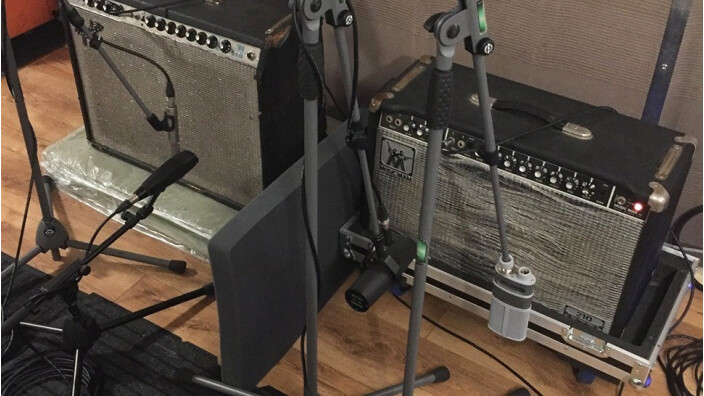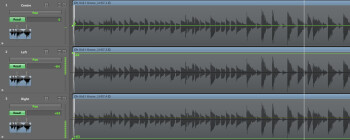Today I will show you a nifty trick derived from the previous installment which will allow you to get an quasi-stereo electric guitar sound with two mono takes.

It’s just an illusion
The basic principle behind this trick is very simple: you only need to record your guitar amp with two mics simultaneously and send their signals to opposite sides of the stereo field with the pan knobs of your DAW. However, for the effect to prove effective and avoid any collateral damage you need to take some precautions. I think a couple of examples will make it easier to understand, so here are some practical cases.
This is the recording that we’ll use a a starting point: a simple rhythm guitar recorded with a Shure SM57 almost flush with the speaker of the amp, pointing right at the center:

I also captured the take with another dynamic mic, a Sennheiser e609, which I placed in a way that allowed me to get a similar result to the SM57:

Spreading the two takes across the stereo field, I get this:

You probably notice a sense of stereo, but nothing to write home about. What’s more, if I reduce this stereo to mono, I get the following:

The tonal character I had chosen in the beginning is nowhere to be found! Why, you ask? Well, because I didn’t take the time to verify how the two mics related to each other in terms of phase…
The result? Hardly what I expected. And if someone were to listen to it through a mono system (say, a cheap speaker…), the sound of the guitar I had painstakingly crafted would be completely unrecognizable. Fortunately you can do much better!
During tracking I also used an AKG C414 placed in such a way that I would get a diametrically opposite sound to that of the SM57:

When I place them on opposites sides of the stereo field, I get this:

The sense of space is much more convincing now! And since I went to the trouble of correcting the phase differences between the two tracks, reducing it to mono doesn’t change the character of the original sound:

So, in order to get a convincing pseudo-stereo sound when recording an electric guitar, you only need to place a second mic to capture a completely different sound to that of the “main” mic, take care of any potential phase issues between mics, and then simply spread the two takes across the stereo field. Do note that you can get a similar, albeit artificial, result during mixdown with one single track, a bit of EQ and some delay on a copy of the original take. The result will sound much more unnatural, at least in my opinion, but that just might be what you are looking for artistically…
Join me next week to discuss the doubling of an electric guitar track.
Download the audio clips (in FLAC format)


